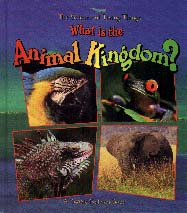| ________________
CM . . . .
Volume V Number 10 . . . . January 15, 1999
excerpt: Sponges are the simplest animals. They grow underwater in different sizes, shapes, and colors. They have a flexible skeleton. Many of the sponges people use for bathing, housecleaning, or washing their car are actually sponge skeletons.Part of the "Science of Living Things Series," this book is a very basic introduction to the animal kingdom. Thirteen chapters, each covering two pages, describe the main animal groups and their characteristics, habitats, reproduction and classification. Children will be fascinated to learn that some members of the animal kingdom do not have a brain or even a head. Information about invertebrates - echinoderms, sponges, worms, mollusks, coelentrates and anthropoids - will perhaps whet kids' appetites for more facts on these types of animals whose numbers far surpass those of the more commonly known vertebrates. Geared to younger students, the text is written in short, simple sentences. Information boxes direct readers' attention to facts about a specific animal or concept. Words in boldface type appear in a glossary. A table of contents and an index are also included. The cover is bold and attractive. Inside the book, photographs abound. Bright and colorful, they match the text. Several of them are placed at an angle or cut into unusual shapes, adding visual interest. All are appropriately labeled. There are also several diagrams. Students looking to do research on a particular animal or animal group will find that the book barely scratches the surface. This book will, however, do very nicely for beginning readers of non-fiction who want a general overview. Recommended. Gail Hamilton is the teacher-librarian at Bird's Hill School, East St. Paul, Manitoba.
To comment on this title or this review, send mail to cm@umanitoba.ca.
Copyright © the Manitoba Library Association.
Reproduction for personal use is permitted only if this copyright notice
is maintained. Any other reproduction is prohibited without
permission.
Published by
TABLE OF CONTENTS FOR THIS ISSUE - JANUARY 15, 1999.
AUTHORS |
TITLES |
MEDIA REVIEWS |
PROFILES |
BACK ISSUES |
SEARCH |
CMARCHIVE |
HOME
|

